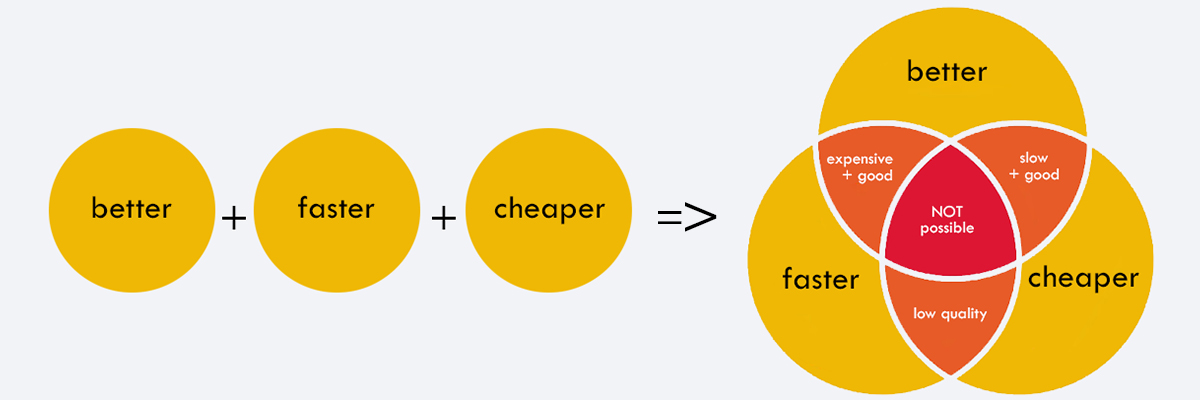Harvard Business School’s Clayton Christensen, estimates that each year there are 30,000 or more new consumer products that are launched into markets each year, of which around 95% of those products fail. Christensen goes on to point out one flaw that individuals tend to focus on when companies develop their product launch marketing. He identified that companies focus in on the wrong method to build a buyer persona. This is the 1st of the 3 tips we’re about to dive into here.
1. Focus Building Buyer Personas on How You Can Solve a Problem Rather Than What are Features
Don’t get us wrong, what a product is will be important. What we can tend to overlook is putting too much focus into tailoring the market to a specific audience or customer segment. Take Christensen’s example of “Hiring a Milkshake”. The fast food company that spent tens of thousands of dollars specifically identifying the milkshake’s end users. From there they looked to build out their value propositions of the milkshake. This feedback was collected from their target market. The company hoped that all this work would lead to a successful launch and bringing in more of their ideal customer base to by more milkshakes. What happened though lead to a unique discovery.
What Happened?
The sales of milkshakes did not ultimately improve after all the time, energy, and money put into building this target audience. The company sought out a fellow researcher of Christensen’s who changed the perspective. You already have a target audience that you asked for feedback on. The problem with the origianal plan was they were looking at the wrong questions. The researcher looked at focusing in not on what makes the product great. What they started to ask, “What job are these customers hiring the milkshake to do?” Listen below to hear more details of what Christensen had to say about these findings:
What the Research showed:
It comes to find our that 40% or more of the milkshakes that were being purchased by commuters on their way to work. When asked, these individuals stated were using the milkshake for a few reasons. First, to give a hand something to do while they navigated their way though traffic on their morning commute. Next, they also heard from these customers were using this to fight the hunger that they would experience before lunch time. They were then asked why not a doughnut or some other pastry from a competitor of the fast food restaurant. The answer was again simple, those items tended to be more messy than a easy to drink milkshake. With this feedback the chain was able to pivot to make their milkshakes more attractive to morning commuters resulting in increased sales of milkshakes.
This really speaks to finding a balance between the product highlights and the product as a solution to a need. Stop putting so much focus on your content into what a particular feature is or services offered. Spend more time building our a customer persona and mapping out the customer journey to really identify the best way to maximize your product launch marketing. Think of it this way, of CBInsights Top 20 reasons startup’s failed, they identified that 42% of the reason was that their was no market need, these companies failed to connect the audience to the offering.
2. Know the Competitors in your Product Market and How to Drive Users and Traffic From Them
This chart from a Harvard Business Review discussion makes one thing clear. It’s extremely difficult to not only get a product to market. It’s even harder to then in turn make it a profitable venture. There’s many factors that play into this. All of which should really be vetting through a detailed SWAT analysis from your marketing team before even starting on the launch marketing strategy. One important factor is failing to identify your competitor list and how you intend to provide them a better solution to their problem than before.
We can turn to the age old adage is better, faster, cheaper. you can have two but not all three. This provides us with a unique way to approach a solid competitive analysis:
- You can have Better and Faster … but you can’t have cheaper
- You can have Faster and Cheaper … but you can’t have better
- You can have Cheaper and Better … but you can’t have faster
When you start to assess each competitor and identify how you stack up to them with this model. Once you identify what makes your product or service better, faster, or cheaper than a competitor, you can work those targeted messages in your product launch marketing, blog posts, emails, social media posts, or arm your sales team with the information. Use this to entice potential customers in your target audience away from a competitor and leading you to a successful product launch.
3. Let Product Marketing Experts Help you so you can Focus on Running a Successful Business
Product launch marketing can lead make or break a company. Another few reason’s that companies fail, per CBInsights is poor marketing (14%), losing focus (13%), and burn out (8%). All of these have something in common. They typically are all experienced by founding or product teams. When you start to focus outside your area of expertise, you tend to start to spread yourself and your team thin. This can be troublesome at any level or stage of the launch campaign, but particularly an issue in the later stages as the team starts to get burned out from having to wear too many hats or from losing focus.
How to Avoid the Losing Focus or Burn Out Pitfalls
Having a group of marketing experts focusing on developing your launch marketing plan, or working in tandem with your product marketing team can help you make sure that your product launch goals aren’t lost in the shuffle. Make sure you chose and marketing expert that has had previous success in marketing campaigns, looks at your launch marketing strategy holistically, and understands what you need to reach your target audience or target market no matter the stage of business you are in to have a successful product launch.
How to Avoid the Poor Marketing Pitfalls
At Creative Direct Marketing Group we understand that you and/or your sales teams need to have the ability to effectively communicate your solution to the problem for your target audience. Whether it’s through interactive demos, building an influencer network to leverage social influencer marketing to building out a successful email marketing series to send our to your existing email list or user base we have you covered right up to launch day. Some key components to our quality product launch plans are:
- Tailored Customer Personas
- Market Share and Detailed Competitor Analysis
- Market Acceptance Testing
- User Experience Testing
- Unique Product Launch Strategy
- Content Creation
- SEO Content Optimization
- Digital Marketing Channels and Social Media Marketing
- Video and Demo Marketing
- Fully trackable Direct Mail
- Customer Feedback and Net Promoter Score (NPS)
- Building Loyal Customers and Growing Current Customers
- Email Marketing
- Analytics and Detailed Reporting
- And Much More
Conclusion
Keep these pieces in mind when you’re reading through other posts or content around product marketing. Some marketing agencies will sell you a cookie cutter product launch strategy focused on maximizing their revenue rather than providing you with unique product insights or a one of a kind launch marketing plan. Other Agencies might focus specifically on a single or two channel market strategy with or might ignore the competitive analysis to focus in on buyer personas that focus only on product features rather than what matters to your target customer base. Looking for help with your next innovative product? Reach out to us here at CDMG and see how we can help you build customer profiles focused on your prospective customers and increase the chance of product launch success through our data driven, omni-channel approach towards marketing your brand’s next big success.
About the Author
 |
Ryan Bradford is currently the Director of Digital Marketing at Creative Direct Marketing Group. He has spent his 10+ year career in client services and marketing focused on highly regulated markets in branding. He is an expert in highly competitive job markets, nutraceuticals, healthcare, financial sector marketing, Regulation A+ marketing. Focus on data driven results, tracking, and compliance. As a result, Ryan maximizes client KPI’s by focusing on metrics that matter, rather than empty metrics. From designing base websites to strategically tailoring each campaign to a clients needs and KPI’s, you will never find Ryan not seeking some way to improve his clients performance across the digital marketing channels. |


